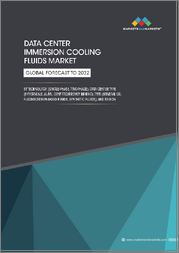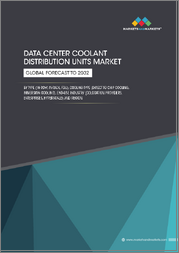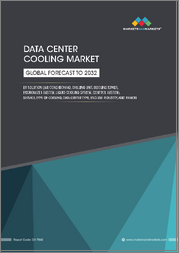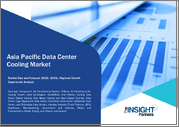
|
시장보고서
상품코드
1637858
아시아태평양의 데이터센터 냉각 시장 : 점유율 분석, 산업 동향과 통계, 성장 예측(2025-2030년)APAC Data Center Cooling - Market Share Analysis, Industry Trends & Statistics, Growth Forecasts (2025 - 2030) |
||||||
아시아태평양의 데이터센터 냉각 시장 규모는 2025년 28억 5,000만 달러, 2030년 40억 7,000만 달러로 추정되며, 예측 기간(2025-2030년)의 CAGR은 7.4%에 달할 것으로 예측됩니다.

아시아태평양의 인공지능(AI) 및 미디어 용도에 의한 방대한 계산 요건으로 인한 인터넷 이용 및 데이터센터 수의 급증으로 데이터센터 냉각 시장은 대규모 성장을 이루고 있습니다.
국제에너지기구(IEA)에 따르면 디지털 서비스에 대한 요구는 지속적으로 증가하고 있습니다. 2010년 이후 세계 인터넷 사용자 인구는 거의 두 배로 증가했으며 세계 웹 트래픽은 20배로 증가했습니다. 한편, 에너지 효율의 대폭적인 향상으로 데이터센터와 데이터 트랜스미션 시스템에 의한 에너지 수요 증가는 억제되고 있으며, 각각 세계 전력 사용량의 1-1.5%를 차지하고 있습니다. 2050년까지 넷 제로 시나리오를 달성하기 위해 향후 10년 동안 에너지 수요와 배출량을 크게 줄이려면 에너지 효율, 연구 개발, 전력 공급 및 공급망 탈탄화에 관한 정부와 기업의 엄청난 노력이 필요합니다.
아시아태평양의 신흥 국가에서 IT 인프라 개발이 시장을 촉진하고 있습니다. 2022년 10월에 발표된 IEA의 데이터에 따르면 아시아의 데이터센터 에너지 수요는 2019년 66TWh에서 2022년 72TWh로 증가했습니다.
아시아태평양의 기업은 기존의 에어컨 대신 자유 공냉 시스템을 사용하는 녹색 데이터센터를 설치하여 이 문제를 해결하려고 합니다. 정보 관리, 보존 및 전달에 녹색 데이터센터를 도입하는 경향이 커지고 있으며, 많은 소프트웨어 비즈니스가 에너지 소비와 총 에너지 비용을 줄이는 데 기여하고 있습니다.
그러나 아시아태평양의 적응성 요구와 정전은 시장 성장의 과제가 되고 있습니다. 일반적인 데이터센터 냉각 시스템은 미리 설계, 표준화 및 모듈화되어야 합니다. 또한 아시아태평양의 데이터센터 요구 사항을 충족하는 유연성과 확장성이 요구됩니다. 고급형 맞춤형 냉각 시스템에는 비용이 많이 들지 않고 비용 절감을 목표로 하는 기업에게는 오늘날의 과제가 되고 있습니다.
시장 기업은 고객에게 더 나은 제품을 제공하기 위해 냉각수 공급자와 협력합니다. 예를 들어, 2023년 8월, 싱가포르의 SK Enmove는 Dell 및 침지 냉각 전문가인 GRC와 제휴하여 냉각액을 제공하기 시작했습니다. 이 윤활 회사는 침수 냉각에 진출하고 있습니다. Dell 키트를 수납하고 서버 제조업체가 공급 및 지원하는 GRC 욕조에 충전하는 유전 냉각제를 제공합니다. SK Enmove는 고품질의 윤활유 기반 오일을 기반으로 한 특수 냉각액을 개발하고 Dell과 GRC는 침지 냉각을 위해 설계된 서버 설계 및 욕조를 제조합니다.
아시아태평양의 데이터센터 냉각 시장 동향
정보기술산업이 가장 높은 성장을 이룰 것
정보기술(IT) 산업은 다양한 산업에서 혁신적인 진보를 가져왔습니다. IT 기술 혁신으로 현저한 성장을 이루는 분야 중 하나가 연구 시장입니다.
또한 아시아태평양은 이 분야에서 현저한 성장을 이루고 있습니다. 기술과 디지털 전환의 엄청난 수요 거점으로서 IT 부문은 과제에 일어나 조사 시장의 개척을 새로운 고도로 밀어 올리고 있습니다.
SaaS 제공업체의 확대로 클라우드 스토리지 제공업체의 용량 확대가 가능해지면서 클라우드 스토리지의 이용이 해마다 확대되고 있어 데이터센터 냉각 시스템 수요가 높아질 가능성이 높습니다. Microsoft, AWS, Google과 같은 클라우드 스토리지 기업들은 보다 효율적인 클라우드 워크플로우를 실현하기 위해 스토리지 용량을 확대하고 있습니다. 이 회사들은 하이퍼스케일 거래에 투자하고 있습니다.
데이터 중심 기술, 클라우드 컴퓨팅, 인공지능(IoT)이 지속적으로 발전함에 따라 데이터센터 수요가 급증하고 있습니다. 기업은 디지털 실적를 확장하고, 대규모 데이터센터와 다양한 지역에 분산된 여러 개의 소규모 시설을 필요로 합니다. 이러한 성장은 이러한 광범위한 인프라의 냉각 요구를 관리하는 데 새로운 도전을 제기합니다.
중국이 큰 시장 점유율을 획득할 전망
데이터센터 냉각은 아시아태평양의 데이터센터 인프라 성장, 디지털 서비스 도입 확대, 클라우드 컴퓨팅의 등장으로 급속히 확대되고 있는 시장입니다. 데이터센터의 필요성이 크게 증가하고 있으며, 그 효과와 최대 가동 시간이 중요합니다.
중국은 데이터센터 건설로 세계 경쟁업체를 추월할 수 있도록 노력하고 있습니다. 5G, 웨어러블 기술, 사물인터넷(IoT), 인공지능의 이용은 데이터 서비스의 안정성과 신뢰성을 보장하기 위해 대규모 조직이 데이터센터의 규모를 확대하려고 하기 때문에 처리 능력에 대한 수요가 급증하고 있습니다.
가속기 프로세서는 인공지능과 이에 필적하는 워크로드가 많은 중국 산업에서 널리 사용됨에 따라 엔터프라이즈 데이터센터에 진출하고 있습니다. 대기 시간의 영향을 받기 쉬운 모든 서비스는 정보를 신속하게 처리하기 위해 가속기 시스템을 사용하는 제로 레이턴시 기술을 요구합니다. 이러한 하드웨어 가속기의 냉각 요구 사항은 상당한 것으로, 200W부터 그 이상의 폭이 있습니다. 강력한 서버와 결합하면 한 대의 기계의 냉각 요구 사항이 1kW에 가까울 수 있습니다. 이 지역의 데이터센터에서는 침지 냉각 기술의 사용이 증가하고 있습니다.
Microsoft Azur와 Amazon Web Services는 대규모 세계 클라우드 데이터센터 네트워크를 구축하고 있습니다. 중국 최대의 전자상거래 기업인 클라우드 컴퓨팅 부문인 Alibaba Group은 이러한 진보에 대항하기 위해 서버의 마더보드를 액체 냉각액에 담그는 데이터센터 냉각 솔루션을 채택하고 있습니다. 이 기술은 액체가 공기보다 더 효과적으로 열을 운반하는 것을 이용합니다. 액침 냉각 솔루션의 에너지 효율 향상으로 데이터센터 운영비는 20% 감소했습니다.
아시아태평양의 데이터센터 냉각 산업 개요
아시아태평양의 데이터센터 냉각 시장은 세분화되어 있으며, 기술에 의해 야기되는 이점과 데이터센터에 효율화 규제를 부과함으로써 정부의 지원이 데이터센터 냉각 시장의 성장에 직접 기여할 것으로 예상됩니다. 기존 시장에서는 대기업의 존재감이 강하고, 시장에의 침투가 진행되고 있습니다. 기술 혁신에 대한 주목이 높아짐에 따라 신기술에 대한 수요가 높아지면서 추가 개발을 위한 투자를 촉진하고 있습니다. 주요 기업은 Vertiv Co., Schneider Electric SE, STULZ GMBH 등입니다.
2024년 5월 리탈은 여러 하이퍼스케일러와 공동으로 모듈식 냉각 시스템을 개발했습니다. 이 솔루션은 직접 수냉에 의해 1MW를 넘는 냉각 능력을 자랑합니다. AI 용도의 고전력 밀도를 수용하도록 특별히 조정되었습니다.
Vertiv는 2024년 4월 AI에 종사하는 기업을 위해 특화된 고밀도 데이터센터 인프라 솔루션의 최신 라인업을 발표했습니다. Vertiv 360AI 시리즈는 AI 중심의 데이터센터에서 증가하는 냉각 및 전력 수요를 수용하도록 설계되었습니다.
2024년 3월, Rittal Private Limited는 인도의 방갈로르 제조 공장에 냉각 유닛 및 액체 냉각 패키지(LCP) 솔루션에 특화된 새로운 통합 센터를 개설했습니다. 이 전략적 움직임은 Rittal의 생산 능력을 강화하고 산업용 냉각 솔루션 수요 증가에 대응할 수 있는 체제를 갖추었습니다.
기타 혜택
- 엑셀 형식 시장 예측(ME) 시트
- 3개월간의 애널리스트·지원
목차
제1장 서론
- 조사의 전제조건과 시장 정의
- 조사 범위
제2장 조사 방법
제3장 주요 요약
제4장 시장 인사이트
- 시장 개요(대상 범위: 데이터센터 냉각과 관련된 현재 지역 동향의 상세한 분석 포함)
- 냉각에 관한 주요 비용의 고찰
- DC 쿨링에 주목한 DC 운용에 관련된 주요 비용 제경비의 분석
- 데이터센터 냉각의 주요 기술 혁신과 발전
- 데이터센터에서 채용되고 있는 주된 에너지 효율화 수법
제5장 시장 역학
- 시장 성장 촉진요인(에너지 소비 중시의 높아, 그린 솔루션에의 이행 등의 주요 요인을, 향후 5-7년간의 상대적 영향에 근거해 매핑)
- 시장 역학(규제의 역동적인 성질, 고객 요구의 진화 등의 주요인을, 향후 5-7년간의 상대적 영향에 근거해 매핑)
- 시장 기회
- 봉쇄된 레이즈드 플로어와 무봉쇄 레이즈드 플로어의 비교
- 산업 생태계 분석
제6장 지역별 데이터센터의 실적의 현황 분석
- 데이터센터의 IT 부하 용량과 면적 실적의 지역 분석(2017-2030년 기간)
- 아시아태평양 지역에서 확립된 DC 시장과 신흥 DC 핫스팟의 지역 분석
- DC 냉각에 관한 규제 틀의 지역 분석
제7장 데이터센터 냉각 시장 세분화
- 냉각 기술별(주요 동향, 2022-2029년 시장 규모 추계·예측, 전망)
- 에어 베이스 냉각
- CRAH
- 칠러 및 이코노마이저
- 냉각탑(직접 냉각, 간접 냉각, 2단계 냉각을 커버)
- 기타
- 액체 냉각
- 액침 냉각
- 직접 칩 냉각
- 리어 도어식 열교환기
- 에어 베이스 냉각
- 최종 사용자 업계별
- IT&텔레콤
- 소매 및 소비재
- 헬스케어
- 미디어&엔터테인먼트
- 연방정부기관
- 기타 최종 사용자
- 국가별
- 중국
- 인도
- 일본
- 호주
- 뉴질랜드
- 싱가포르
- 한국
- 말레이시아
- 인도네시아
- 필리핀
- 대만
- 홍콩
- 태국
- 베트남
제8장 경쟁 구도
- 기업 프로파일
- Vertiv Group Corp.
- Stulz GmbH
- Schneider Electric SE
- Rittal Gmbh & Co. KG
- Mitsubishi Electric Corporation
- Johnson Controls Inc.
- Munters Group
- Eaton Corporation plc
- Daikin Industries Limited
- Asetek A/S
제9장 투자 분석
제10장 시장 기회와 앞으로의 동향
JHS 25.02.12The APAC Data Center Cooling Market size is estimated at USD 2.85 billion in 2025, and is expected to reach USD 4.07 billion by 2030, at a CAGR of 7.4% during the forecast period (2025-2030).
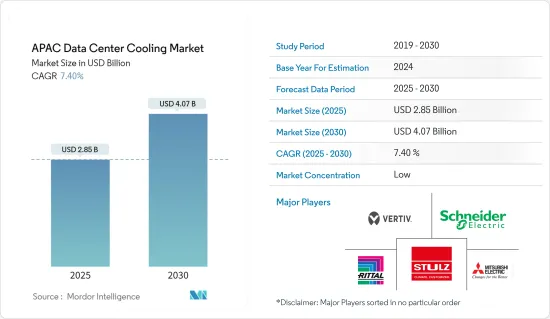
Due to the surge in Internet usage and the number of data centers due to enormous computational requirements by artificial intelligence (AI) and media applications in Asia-Pacific (APAC), the data center cooling market has had massive growth.
According to the International Energy Agency (IEA), the need for digital services is continuously increasing. Since 2010, the global population of internet users has nearly doubled, while global web traffic has increased 20-fold. On the other hand, significant advances in energy efficiency have helped to restrain the increase in energy demand from data centers and data transmission systems, each contributing to 1-1.5% of worldwide power use. Substantial government and business efforts on energy efficiency, research and development, and decarbonizing power supply and supply chains are required to cut energy demand and emissions significantly over the next decade to meet the Net Zero by 2050 Scenario.
Development in IT Infrastructure in emerging countries of APAC is propelling the market. The data center energy demand increased from 66 TWh in 2019 to 72 TWh in 2022 in Asia, according to IEA data released in October 2022.
Companies in the APAC region are trying to tackle this issue by setting up Green data centers that use Free air cooling systems instead of traditional Air conditioners. The increasing trends toward deploying green data centers for managing, storing, and distributing information have helped many software businesses decrease energy consumption and total energy costs.
However, adaptability demands and power outages in Asia-Pacific are a challenge to the growth of the market. A typical data center cooling system must be pre-engineered, standardized, and modular. It is expected to be flexible and scalable to match the data center's requirements in the region. This is challenging today, with firms looking to lower costs and not spend much on high-end customized cooling systems.
The players in the market are collaborating with cooling fluids providers to provide better products to their customers. For instance, in August 2023, Singapore's SK Enmove partnered with Dell and immersion cooling expert GRC to provide cooling fluids. The lubrication company is moving into immersion cooling. It will provide dielectric coolants to fill GRC's tubs, which will hold the Dell kit and be supplied and supported by the server maker. SK Enmove will develop specialized cooling fluids based on its high-quality lube base oil, while Dell and GRC will produce server designs and tubs designed for immersion cooling.
APAC Data Center Cooling Market Trends
Information Technology Industry to Witness Highest Growth
The Information Technology (IT) vertical has driven transformative advancements in various industries. One area that has witnessed remarkable growth due to IT innovation is the market studied.
Moreover, Asia-Pacific is experiencing significant growth in this segment. As a thriving demand hub for technology and digital transformation, the IT sector has risen to the challenge, propelling the development of the market studied to new heights.
Cloud storage use has expanded over the years as SaaS provider expansion has enabled cloud storage providers to expand their capacity, which is likely to raise demand for data center cooling systems. Cloud storage companies like Microsoft, AWS, and Google are expanding their storage capacity to enable more efficient cloud workflow. These firms are investing in hyperscale transactions.
As data-driven technologies, cloud computing, artificial intelligence, and (IoT) continue to evolve, the demand for data centers has skyrocketed. Companies are expanding their digital footprints, requiring larger data centers or multiple smaller facilities spread across various regions. This growth has introduced new challenges in managing the cooling needs of these sprawling infrastructures.
China is Expected to Witness Significant Market Share
Data center cooling is a market that is expanding quickly in Asia-Pacific due to the region's growing data center infrastructure, rising adoption of digital services, and the emergence of cloud computing. The need for data centers is increasing significantly and placing a greater emphasis on effectiveness and maximum uptime.
China is putting much effort toward overtaking its competitors globally in the construction of data centers. The use of 5G, wearable technology, the Internet of Things (IoT), and artificial intelligence generates a booming demand for processing capacity as larger organizations attempt to scale up their data centers to assure the stability and reliability of data services.
Accelerator processors are entering the enterprise data center as artificial intelligence and comparable workloads become commonplace in numerous Chinese industries. All latency-sensitive services demand zero-latency technologies that use accelerating systems to handle information rapidly. The cooling requirements for these hardware accelerators are considerable and range from 200 W to more. The cooling requirements of a single machine can be almost 1 kW when paired with a powerful server. In the region's data centers, this has increased the use of immersion cooling technologies.
Microsoft Azure and Amazon Web Services are constructing massive global cloud data center networks. Alibaba Group, the cloud computing division of China's largest e-commerce company, uses a data center cooling solution that submerges server motherboards in liquid coolant to compete with these advancements. This technique makes use of liquid's more effective ability to transport heat than air. The energy efficiency enhancements of the immersion cooling solution led to a 20% decrease in data center operating expenses.
APAC Data Center Cooling Industry Overview
The Asia-Pacific data center cooling market is fragmented as the advantages offered by the technology and aid from the government by imposing efficiency regulations on data centers are expected to help the growth of the data center cooling market directly. Market penetration is growing with a strong presence of major players in established markets. With the increasing focus on innovation, the demand for new technologies is growing, which, in turn, is driving investments for further developments. Key players are Vertiv Co., Schneider Electric SE, STULZ GMBH, etc.
In May 2024, Rittal developed a modular cooling system in collaboration with multiple hyperscalers. This solution boasts a cooling capacity exceeding 1 MW, achieved through direct water cooling. It's specifically tailored to cater to the high power densities of AI applications.
In April 2024, Vertiv unveiled its latest lineup of high-density data center infrastructure solutions tailored specifically for enterprises delving into AI. The Vertiv 360AI series is crafted to cater to AI-driven data centers' augmented cooling and power demands.
In March 2024, Rittal Private Limited marked the opening of its new Integration Centre, specifically tailored for Cooling Units and Liquid Cooling Package (LCP) solutions, at its Bangalore, India manufacturing plant. This strategic move bolsters the company's production capabilities and positions it to cater to the escalating demand for Industrial Cooling Solutions.
Additional Benefits:
- The market estimate (ME) sheet in Excel format
- 3 months of analyst support
TABLE OF CONTENTS
1 INTRODUCTION
- 1.1 Study Assumptions and Market Definition
- 1.2 Scope of the Study
2 RESEARCH METHODOLOGY
3 EXECUTIVE SUMMARY
4 MARKET INSIGHTS
- 4.1 Market Overview (Coverage: A detailed analysis of the current regional trends related to Data Center Cooling are included in this section)
- 4.2 Key cost considerations for Cooling
- 4.2.1 Analysis of the key cost overheads related to DC operations with an eye on DC Cooling
- 4.2.2 Key innovations and developments in Data Center Cooling
- 4.2.3 Key energy efficiency practices adopted in Data Centers
5 MARKET DYNAMICS
- 5.1 Market Drivers (Key factors such as the increased emphasis on energy consumption, move towards green solutions are mapped based on their relative impact over the next 5-7 years)
- 5.2 Market Challenges (Key factors such as the dynamic nature of regulations, evolving customer needs are mapped based on their relative impact over the next 5-7 years)
- 5.3 Market Opportunities
- 5.4 Comparison of raised floor with containment & raised floor without commitment
- 5.5 Industry Ecosystem Analysis
6 ANALYSIS OF THE CURRENT REGIONAL DATA CENTER FOOTPRINT
- 6.1 Regional Analysis of IT Load Capacity & Area Footprint of Data Centers (for the period of 2017-2030)
- 6.2 Regional Analysis of the Established DC Markets and Emerging DC Hotspots in APAC region (we will include coverage by highlighting major established and emerging DC markets)
- 6.3 Regional Analysis of Regulatory Framework On DC Cooling
7 DATA CENTER COOLING MARKET SEGMENTATION
- 7.1 By Cooling Technology (Key trends, market size estimates & projections for the period of 2022-2029 and future outlook)
- 7.1.1 Air-based Cooling
- 7.1.1.1 CRAH
- 7.1.1.2 Chiller and Economizer
- 7.1.1.3 Cooling Tower (covers direct, indirect & two-stage cooling)
- 7.1.1.4 Others
- 7.1.2 Liquid-based Cooling
- 7.1.2.1 Immersion Cooling
- 7.1.2.2 Direct-to-Chip Cooling
- 7.1.2.3 Rear-Door Heat Exchanger
- 7.1.1 Air-based Cooling
- 7.2 By End-user Vertical
- 7.2.1 IT & Telecom
- 7.2.2 Retail & Consumer Goods
- 7.2.3 Healthcare
- 7.2.4 Media & Entertainment
- 7.2.5 Federal & Institutional agencies
- 7.2.6 Other end-users
- 7.3 By Country
- 7.3.1 China
- 7.3.2 India
- 7.3.3 Japan
- 7.3.4 Australia
- 7.3.5 New Zealand
- 7.3.6 Singapore
- 7.3.7 South Korea
- 7.3.8 Malaysia
- 7.3.9 Indonesia
- 7.3.10 Philippines
- 7.3.11 Taiwan
- 7.3.12 Hong Kong
- 7.3.13 Thailand
- 7.3.14 Vietnam
8 COMPETITIVE LANDSCAPE
- 8.1 Company Profiles
- 8.1.1 Vertiv Group Corp.
- 8.1.2 Stulz GmbH
- 8.1.3 Schneider Electric SE
- 8.1.4 Rittal Gmbh & Co. KG
- 8.1.5 Mitsubishi Electric Corporation
- 8.1.6 Johnson Controls Inc.
- 8.1.7 Munters Group
- 8.1.8 Eaton Corporation plc
- 8.1.9 Daikin Industries Limited
- 8.1.10 Asetek A/S






